麻醉药(Anesthetic Agents)
- 格式:doc
- 大小:199.00 KB
- 文档页数:6
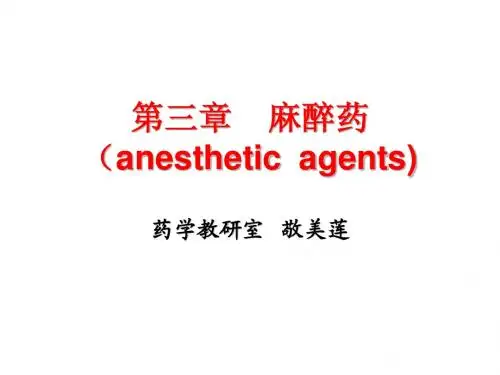
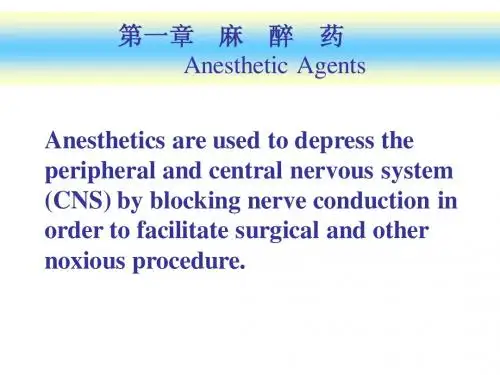
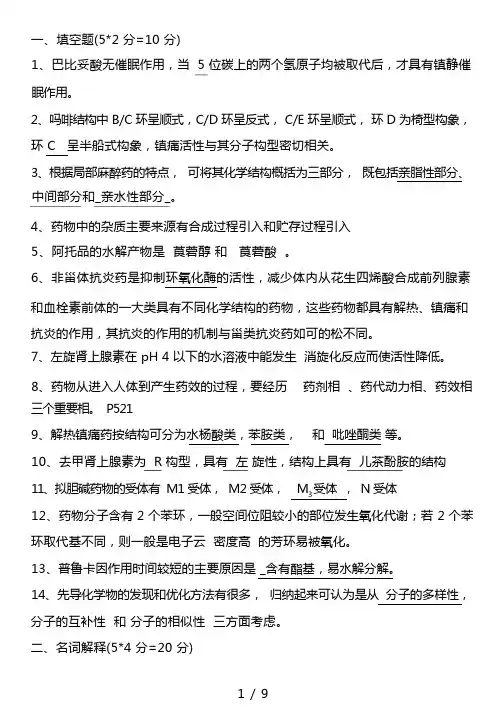
一、填空题(5*2 分=10 分)1、巴比妥酸无催眠作用,当 5 位碳上的两个氢原子均被取代后,才具有镇静催眠作用。
2、吗啡结构中 B/C 环呈顺式,C/D 环呈反式, C/E 环呈顺式,环 D 为椅型构象,环 C 呈半船式构象,镇痛活性与其分子构型密切相关。
3、根据局部麻醉药的特点,可将其化学结构概括为三部分,既包括亲脂性部分、中间部分和_亲水性部分_。
4、药物中的杂质主要来源有合成过程引入和贮存过程引入5、阿托品的水解产物是莨菪醇和莨菪酸。
6、非甾体抗炎药是抑制环氧化酶的活性,减少体内从花生四烯酸合成前列腺素和血栓素前体的一大类具有不同化学结构的药物,这些药物都具有解热、镇痛和抗炎的作用,其抗炎的作用的机制与甾类抗炎药如可的松不同。
7、左旋肾上腺素在 pH 4 以下的水溶液中能发生消旋化反应而使活性降低。
8、药物从进入人体到产生药效的过程,要经历药剂相、药代动力相、药效相三个重要相。
P5219、解热镇痛药按结构可分为水杨酸类,苯胺类,和吡唑酮类等。
10、去甲肾上腺素为 R 构型,具有左旋性,结构上具有儿茶酚胺的结构受体, N 受体11、拟胆碱药物的受体有 M1 受体, M2 受体, M312、药物分子含有 2 个苯环,一般空间位阻较小的部位发生氧化代谢;若 2 个苯环取代基不同,则一般是电子云密度高的芳环易被氧化。
13、普鲁卡因作用时间较短的主要原因是 _含有酯基,易水解分解。
14、先导化学物的发现和优化方法有很多,归纳起来可认为是从分子的多样性,分子的互补性和分子的相似性三方面考虑。
二、名词解释(5*4 分=20 分)1.*组合化学(combinatorialchemistry) :是一门将化学合成、组合理论、计算机辅助设计及机械手结合一体,并在短时间内将不同构建模块用巧妙构思,根据组合原理,系统反复连接,从而产生大批的分子多样性群体,形成化合物库,然后,运用组合原理,以巧妙的手段对库成分进行筛选优化,得到可能的有目标性能的化合物结构的科学。
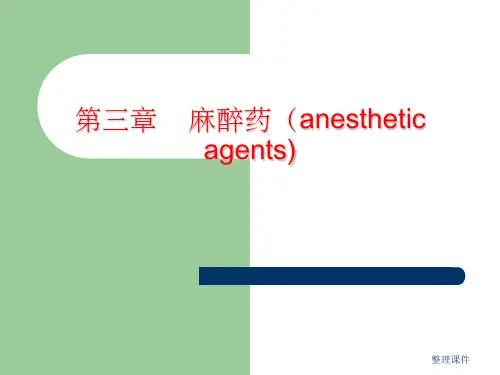

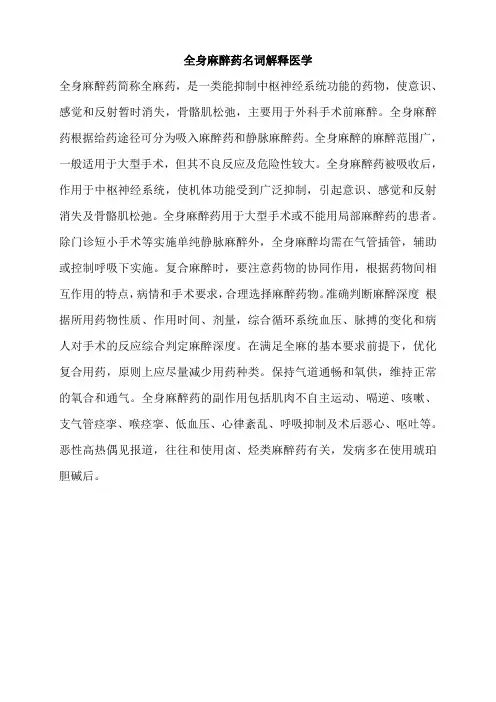
全身麻醉药名词解释医学
全身麻醉药简称全麻药,是一类能抑制中枢神经系统功能的药物,使意识、感觉和反射暂时消失,骨骼肌松弛,主要用于外科手术前麻醉。
全身麻醉药根据给药途径可分为吸入麻醉药和静脉麻醉药。
全身麻醉的麻醉范围广,一般适用于大型手术,但其不良反应及危险性较大。
全身麻醉药被吸收后,作用于中枢神经系统,使机体功能受到广泛抑制,引起意识、感觉和反射消失及骨骼肌松弛。
全身麻醉药用于大型手术或不能用局部麻醉药的患者。
除门诊短小手术等实施单纯静脉麻醉外,全身麻醉均需在气管插管,辅助或控制呼吸下实施。
复合麻醉时,要注意药物的协同作用,根据药物间相互作用的特点,病情和手术要求,合理选择麻醉药物。
准确判断麻醉深度根据所用药物性质、作用时间、剂量,综合循环系统血压、脉搏的变化和病人对手术的反应综合判定麻醉深度。
在满足全麻的基本要求前提下,优化复合用药,原则上应尽量减少用药种类。
保持气道通畅和氧供,维持正常的氧合和通气。
全身麻醉药的副作用包括肌肉不自主运动、嗝逆、咳嗽、支气管痉挛、喉痉挛、低血压、心律紊乱、呼吸抑制及术后恶心、呕吐等。
恶性高热偶见报道,往往和使用卤、烃类麻醉药有关,发病多在使用琥珀胆碱后。
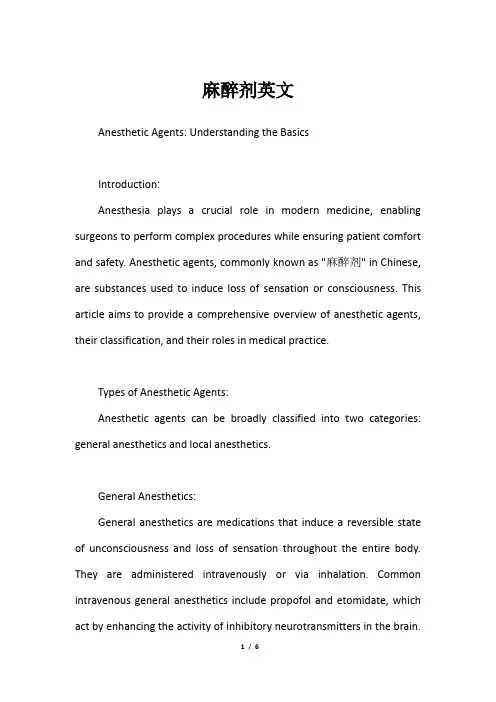
麻醉剂英文Anesthetic Agents: Understanding the BasicsIntroduction:Anesthesia plays a crucial role in modern medicine, enabling surgeons to perform complex procedures while ensuring patient comfort and safety. Anesthetic agents, commonly known as "麻醉剂" in Chinese, are substances used to induce loss of sensation or consciousness. This article aims to provide a comprehensive overview of anesthetic agents, their classification, and their roles in medical practice.Types of Anesthetic Agents:Anesthetic agents can be broadly classified into two categories: general anesthetics and local anesthetics.General Anesthetics:General anesthetics are medications that induce a reversible state of unconsciousness and loss of sensation throughout the entire body. They are administered intravenously or via inhalation. Common intravenous general anesthetics include propofol and etomidate, which act by enhancing the activity of inhibitory neurotransmitters in the brain.Inhalation anesthetics, such as sevoflurane and isoflurane, are delivered via a breathing mask and provide rapid induction and maintenance of anesthesia.Local Anesthetics:Unlike general anesthetics, local anesthetics act by blocking the transmission of nerve impulses in a specific area, numbing the region and allowing for painless surgical procedures. Local anesthetics can be administered topically, through infiltration, or via nerve blocks. Lidocaine and bupivacaine are commonly used local anesthetics due to their efficacy and safety profile.Mechanism of Action:The mechanism of action of anesthetic agents varies depending on the type. General anesthetics work by altering the functioning of neurotransmitters in the central nervous system, leading to inhibition of neuronal activity and loss of consciousness. Local anesthetics, on the other hand, block sodium channels in nerve fibers, preventing the conduction of pain signals.Clinical Applications:Anesthetic agents are used in various medical procedures, rangingfrom minor surgeries to major interventions. General anesthetics are indispensable in surgeries requiring complete unconsciousness, such as cardiac surgeries, abdominal surgeries, and neurosurgical procedures. Local anesthetics find utility in dental procedures, skin surgeries, and pain management during labor.Safety Considerations:While anesthetic agents are generally safe when administered by trained professionals, they are not without risks. Possible complications include allergic reactions, respiratory depression, cardiovascular instability, and postoperative nausea and vomiting. These risks are mitigated by careful patient selection, comprehensive preoperative assessment, and vigilant monitoring during anesthesia administration.Conclusion:In conclusion, anesthetic agents are essential tools in modern medicine, allowing for painless surgical interventions and ensuring patient comfort. Understanding the classification, mechanism of action, and clinical applications of these agents is crucial for healthcare professionals involved in anesthesia management. By balancing the benefits and risks, anesthetic agents contribute significantly to improving patient outcomes and enhancing the quality of healthcare delivery.Anesthetic AgentsIntroduction:Anesthesia is a critical component of modern medicine, allowing surgeons to perform procedures without causing pain or discomfort to patients. Anesthetic agents play a vital role in this process, providing temporary loss of sensation and consciousness. In this article, we will explore the various types of anesthetic agents commonly used in medical practice.Types of Anesthetic Agents:1. Local Anesthetics:Local anesthetics are primarily used to provide localized pain relief. They work by blocking the nerve signals in a specific area, numbing the region and preventing pain sensation. Commonly used local anesthetics include lidocaine, bupivacaine, and procaine. These agents are typically administered via injection or topical application.2. General Anesthetics:General anesthetics induce a reversible loss of consciousness, allowing surgeons to perform complex procedures without causing anydiscomfort to patients. These agents are usually administered through inhalation or intravenous injection. Some commonly used general anesthetics include sevoflurane, propofol, and desflurane.3. Regional Anesthetics:Regional anesthetics are used to numb larger areas of the body, such as an entire limb or a specific region. These agents block nerve signals along a specific nerve pathway, resulting in loss of sensation in the targeted area. Examples of regional anesthetics include epidural and spinal anesthesia, which are frequently used during childbirth or orthopedic surgeries.4. Intravenous Anesthetics:Intravenous (IV) anesthetics are administered directly into the bloodstream to induce sedation and relaxation. These agents work rapidly, allowing for quick onset and offset of anesthesia. Commonly used IV anesthetics include midazolam, propofol, and ketamine.5. Topical Anesthetics:Topical anesthetics are applied directly to the skin or mucous membranes to provide localized pain relief. These agents are commonly used during minor surgical procedures, dental work, or to alleviatediscomfort from skin conditions. Lidocaine and benzocaine are popular topical anesthetics utilized in medical practice.Safety and Considerations:While anesthetic agents are essential in modern medicine, it is crucial to consider their potential risks and side effects. Allergic reactions, respiratory depression, and interactions with other medications are some of the risks associated with anesthesia. Therefore, it is crucial for healthcare professionals to carefully evaluate a patient's medical history and tailor the selection and dosage of anesthetic agents accordingly.Conclusion:Anesthetic agents are invaluable tools in the field of medicine, ensuring patient comfort and safety during surgical procedures. From local anesthetics to general anesthetics, each type serves a specific purpose, allowing healthcare professionals to perform intricate surgeries and interventions without causing pain or distress. By understanding the different types of anesthetic agents and their applications, medical professionals can provide effective pain management and optimal patient care.。

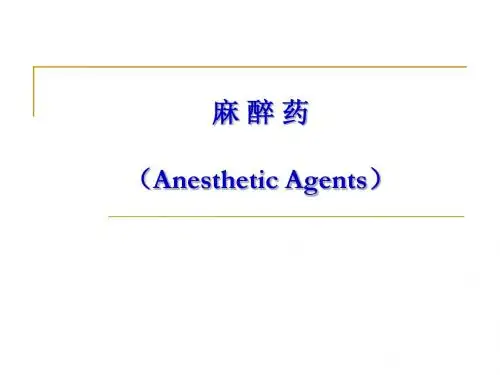

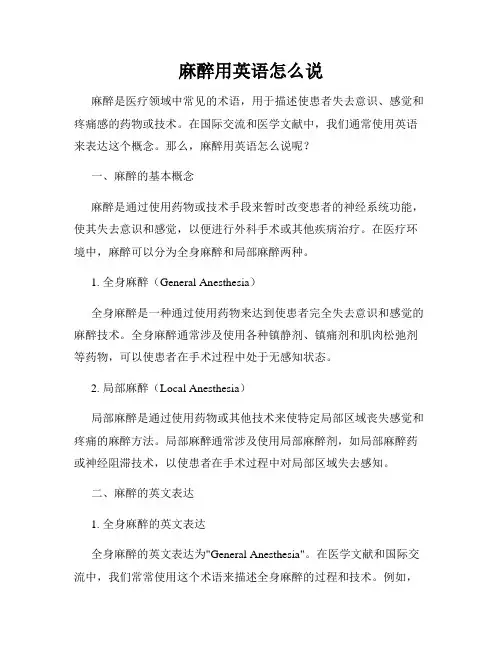
麻醉用英语怎么说麻醉是医疗领域中常见的术语,用于描述使患者失去意识、感觉和疼痛感的药物或技术。
在国际交流和医学文献中,我们通常使用英语来表达这个概念。
那么,麻醉用英语怎么说呢?一、麻醉的基本概念麻醉是通过使用药物或技术手段来暂时改变患者的神经系统功能,使其失去意识和感觉,以便进行外科手术或其他疾病治疗。
在医疗环境中,麻醉可以分为全身麻醉和局部麻醉两种。
1. 全身麻醉(General Anesthesia)全身麻醉是一种通过使用药物来达到使患者完全失去意识和感觉的麻醉技术。
全身麻醉通常涉及使用各种镇静剂、镇痛剂和肌肉松弛剂等药物,可以使患者在手术过程中处于无感知状态。
2. 局部麻醉(Local Anesthesia)局部麻醉是通过使用药物或其他技术来使特定局部区域丧失感觉和疼痛的麻醉方法。
局部麻醉通常涉及使用局部麻醉剂,如局部麻醉药或神经阻滞技术,以使患者在手术过程中对局部区域失去感知。
二、麻醉的英文表达1. 全身麻醉的英文表达全身麻醉的英文表达为"General Anesthesia"。
在医学文献和国际交流中,我们常常使用这个术语来描述全身麻醉的过程和技术。
例如,在科学论文中可以这样描述:“The patient was placed under general anesthesia before the surgery started.”(手术开始前,患者接受了全身麻醉。
)2. 局部麻醉的英文表达局部麻醉的英文表达为"Local Anesthesia"。
这个术语在医学领域常被用来描述局部麻醉的过程和技术。
举个例子,在学术会议上,我们可以这样讲述:“The dentist administere d local anesthesia to numb the patient's gums before starting the procedure.”(牙医在手术前给患者的牙床上注射了局部麻醉药物,使其失去感觉。
法医学名词解释法医学是一门研究在法律程序中应用医学知识和技术来解决法律问题的学科。
法医学涉及多个方面,其中包括了很多专业的术语和名词。
以下是对一些常见法医学术语的解释:1. 尸斑(Lividity):尸斑是指尸体死后由于血液向下流动而产生的紫红色斑痕。
尸斑可帮助法医判断尸体的死亡时间和尸体在死后是否移动过。
2. 尸硬直(Rigor mortis):尸硬直是指尸体死后肌肉因缺乏能量而逐渐硬化的过程。
尸硬直开始于死亡后几小时,最终在一天到两天后消失。
通过尸硬直可以推断死亡时间。
3. 尸体的腐烂(Decomposition):腐烂是指尸体在死后逐渐分解的过程。
腐烂的速度和过程取决于环境条件、温度和尸体的状态等因素。
法医学通过观察和分析尸体的腐烂程度来确定死亡时间。
4. 遗留痕迹(Trace evidence):遗留痕迹是指犯罪现场或物证中留下的微小物质或痕迹,例如血液、指纹、纤维,可通过DNA分析、显微镜检查等方法获取信息。
5. 法医病理学(Forensic pathology):法医病理学是研究通过尸体解剖、病理检查和组织学分析来确定死因和死亡方式的学科。
6. 遗传学证据(Genetic evidence):遗传学证据是通过研究DNA样本来识别个体或与特定人员相关的证据。
遗传学证据在解决亲子关系、犯罪案件和身份认证等领域起着重要的作用。
7. 麻醉药物(Anesthetic drugs):麻醉药物是用于控制病人意识和疼痛感觉的药物,对于法医学而言,麻醉药物还可用于解剖尸体或进行尸体检查。
8. 临床法医学(Clinical forensic medicine):临床法医学是法医学的一个分支,主要关注妇女和儿童的侵害和虐待等问题,如性侵害的体检和伤害鉴定等。
9. 司法精神病学(Forensic psychiatry):司法精神病学是研究心理疾病与法律之间关系的学科。
司法精神病学家在犯罪评估、心理状况鉴定和判定刑责等方面提供专业意见。
麻醉药(Anesthetic Agents )
麻醉药是作用于神经系统使其收到抑制,从而起到麻醉作用的药物。
根据其作用的部位不同,麻醉药又分为全身麻醉药和局部麻醉药。
全身麻醉药(general anesthetics )作用于中枢神经系统,使其受到可逆的抑制,从而使意识、感觉特别是痛觉和反射消失,便于进行外科手术。
局部麻醉药(local anesthetics )作用于神经末梢及神经干,可逆性地阻滞神经冲动的传导,使局部的感觉(痛觉)消失,而不影响意识,便于进行局部的手术及治疗。
肌肉松弛药(Muscular Relaxants )常作为麻醉药物的辅助用药。
第一节 全身麻醉药
全身性麻醉药物根据给药途径不同分为吸入性麻醉药(inhalation anesthetics )和静脉麻醉药(intravenous anesthetics )。
1) 吸入性麻醉药通常是一类化学性质不活泼的气体或易挥发性液体,又叫作挥发性麻醉药,这些药物与一定比例的空气或氧气混合后,由呼吸进入肺泡,扩散进入血液,分部至神经组织,发挥麻醉作用。
吸入性麻醉药物主要有气态药物(氧化亚氮)及小分子的短链化合物(分子量较小的烃类、醚类、氟代烷烃类等)现在氟代烃麻醉药几乎完全取代了过去的挥发性麻醉药。
*氟烷:CF 3CHBrCl (1958)
*甲氧氟烷:CH 3OCF 2CHCl 2 (1962) *恩氟烷:CHF 2OCF 2CHFCl (1976) *异氟烷:CHF 2OCHClCF 3 (1982) *七氟烷:CH 2FOCH(CF 3)2 (1990) *地氟烷:CHF 2OCHFCF 3
2) 静脉麻醉药又称为非吸入性全身麻醉药,是通过静脉注入随血液循环进入中枢神经后才能产生全麻作用的药物。
最早应用的静脉注射药物为巴比妥类药物,作用迅速,起效快,但持续作用短,常用于小手术,或与其它麻醉药物配合使用,代表药物有:海索比妥钠、硫喷妥钠、美索比妥钠等。
N N
O R 1R 2
O
3
X -. Na +
后非巴比妥类药物在临床上得到广泛应用,代表药物为: 盐酸氯胺酮 依托咪酯
NHCH 3 .HCl
O
Cl
N
N
O
O
第二节 局部麻醉药
局部麻醉药和全麻药(从作用机制来讲)的根本区别在于:局部麻醉药与神经膜上钠离子通道的特定部位结合后,通过减少钠离子穿过离子通道,影响膜电位,从而阻断神经冲动的传导,而全身麻醉药则是通过影响神经膜的物理性状,如膜的流体性质、通透性能而发挥作用。
1) 局部麻醉药的发展
1860年Niemann从古柯树叶中提取出活性成分,命名为可卡因,又名古柯碱,1884年Koller 发现其局麻作用首次应用于临床(副作用:成瘾性,组织刺激,对水溶液不稳定等)N
COOH
CH3OH
后人们进一步发现
N
O
HN
CO2Me
O
O
HN
O
有活性,说明双环结构并不是达到麻醉效果所必须的基团。
1890年Ritsert合成对氨基苯甲酸乙酯(即苯佐卡因),发现其具有局部麻醉作用,后合成了大量的芳香酸酯类化合物,发现了阿索方和新阿索方均有较强的局麻作用,结构如下:
COOMe
H2N
HO
COOMe
HO
H2N但该药物在血液中的溶解度过小,不能注射应用,制成盐酸盐,酸性太强,也不能应用。
终于,在1904年合成了局部麻醉作用优良的普鲁卡因(Procaine):
H2N
O
OCH2CH2N(C2H5)2
从可卡因结构的研究到苯佐卡因的发现,改造得到普鲁卡因的过程,是以天然化合物结构出发设计和发现新药的典型例子之一。
NO 2
Na 2Cr 2O 7
24
NO 2
HOCH CH N(C H )NO 2
2CH 2N(C 2H 5)2
Fe, HCl
HCl .H 2N
O
OCH 2CH 2N(C 2H 5)2
HCl
2)局部麻醉
药的结构类型*对氨基苯甲酸酯类
氯普鲁卡因(Chloroprocaine)的局部麻醉作用比普鲁卡因强两倍,毒性小约1/3,作用迅速持久,临床上用于各种手术麻醉。
羟普鲁卡因(Hydroxyprocaine)的局部麻醉作用均比普鲁卡因强,作用时间也较长。
苯环上氨基的氢以烃基取代,可以增强局麻作用,如丁卡因(Tetracaine)。
将普鲁卡因苯环上的氨基以烷氧基取代时,其局部麻醉作用与氨基化合物相似,如对乙氧卡因(Parethoxycaine)。
改变侧链氨基上的取代基或侧链中引入取代基,有些化合物的局部麻醉作用比普鲁卡因强,如布他卡因(Butacaine)的作用比普鲁卡因强三倍,可用于浸润麻醉和表面麻醉。
徒托卡因(Tutocaine)的烷氨基比普鲁卡因小,但碳链比普鲁卡因长。
二甲卡因(地美卡因Dimethocaine)与徒托卡因的作用相似。
侧链上的甲基增加了立体障碍,使酯键不易水解。
羧酸酯中的氧原子若以其电子等排体S 置换,脂溶性增大,显效快。
硫卡因(Thiocaine)的局麻作用较普鲁卡因强,毒性也比普鲁卡因大,可用于浸润麻醉及表面麻醉。
(生物电子等排体:具有同样电子数与排列的化合物或基团或者是具有相似的立体电子构型的基团具有相同或相似的生理活性。
N
H 2COOCH 2CH 2N[C 2H 5]2
R
n-C 4
H 9NH
COOCH 2CH 2N[C 2
H 5]2
N
H 2
2H 5
]
2
C 2H 5O
COOCH 2CH 2N[C 2H 5]2
N H 2COOCH 2CH 2N[C 4H 9]2
N
H 2COSCH 2CH 2N[C 2H 5]2
例如:C N O F CH NH OH CH 2 NH 2
CH 3等)
*酰胺类
在酰胺类局麻药中,最早合成的化合物为尼万宁(Nirvanine),由于其刺激性太大而不能用作局麻药。
三十年代,人们又研究酰胺类化合物的局麻作用,从中发现利多卡因(Lidocaine)其局麻作用比普鲁卡因强两倍,具有中等脂溶性,穿透力较强,作用快,时效长,适用于各种局部麻醉。
利多卡因的成功开辟了酰苯胺类局部麻醉药研究的新领域,先后又有三甲卡因(Trimecaine),丙胺卡因(Prilocaine),卡波卡因(Carbocaine),布比卡因(丁哌卡因Bupivacaine)等得到临床上的广泛应用,它们除具有类似利多卡因的局部麻醉作用外,在作用强度、持续时间上各自不同。
HO NHCOC 2N(C 2H 5)2
H 3COOC
NHCOC 2N(C 2H 5)2CH 3
CH 3
Nirvanine
Lidocaine
CH 3
NHCO 3H 7
CH 3
CH 3
CH 3
CH 3
CH 3
3
N 3
O Trimecaine NH
O
CH 2N(C 2H 5)2
Bupivacaine Prilocaine
盐酸利多卡因的合成:
NO 2
Fe,HCl
NH 2
ClCH 2COCl
NH
O
Cl
252
NHCOC 2N(C 2H 5)2 .HCl
CH 3
CH 3
HCl
*氨基酮类药物
以电子等排体-CH2-代替酯基中的-O-则为氨基酮类化合物。
在氨基酮类中,不少化合物具有局麻作用,其中一些作用相当强,在临床上具有应用价值的
如法立卡因(Falicaine)和达克罗宁(Dyclonine),后者的表面麻醉作用很强,显效快,二者均为表面麻醉剂,后者应用较多。
*氨基醚类药物
用醚健代替局麻药结构中的酯基或酰胺基,得到氨基醚类药物。
二甲异喹(Dimethisoguin 或喹尼索卡因Quinisocaine)和普拉莫辛(Pramoxine,普莫卡因)均用作表面麻醉药。
二甲异喹的表面麻醉作用比可卡因强约1000倍,而毒性仅为可卡因的两倍。
醚键比酯和酰胺基稳定,可能是其麻醉持久的原因。
三、局部麻醉药的构效关系
Ar
O
X
C
N
n A B C D
A :为亲酯性部分,为芳香基团或是其它杂环取代物
1、芳香环上引入致活基团,活性增加,NH
2、RNH 、OH 、CH 3 2、引入吸电子基团,活性降低
3、活性比较苯基>吡咯>噻吩>呋喃
4、当为氨基苯甲酸酯类药物氨基上的氢被烷基取代时,活性增加,但毒性也增加(例如丁卡因) B :酯基被替代
1、-COS ->-COO ->-COCH 2->-CONH -跟油水分布吸收有关
2、稳定性使活性时间延长-COCH 2->-CONH ->-COS ->-COO -
3、但当结构成为Ar -NH -COR 时活性得到大大的提高 C :1、碳链延长,n 越大,活性增加,毒性增加,一般n 为2,3 2、碳链上引入支链,位阻增加,使难以水解,作用时间增加 D :亲水性部分
1、如为伯胺,刺激性大
2、为仲胺,C3~C5
3、常为叔胺,-N(C 2H 5)2,可用哌啶环或是吡咯环等替代
RO
COCH 2CH 2
N
R = C 3H 7R = C
4H 9
N C 4H 9
OCH 2CH 2N(CH 3)2
C 4H 9O
O(CH 2)
3
N O。